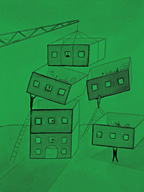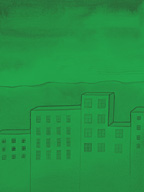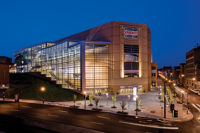Issue: 7/05
As our industry changes and grows with the 21st century, it is the responsibility of every member of a design and construction team to embrace and promote new technologies, methodologies, and most of all, paradigms. A paradigm is defined by Webster's dictionary as "a philosophical and theoretical framework of any kind."
Overview
The most important aspect of sustainability that the plumbing designer must understand is the concept of integration. Because plumbing design decisions can have both positive and negative impact on non-plumbing aspects of the overall design it is imperative that the plumbing designer be an active member of the team as early in the process as possible. Initially this will assist the plumbing designer in understanding and embracing the project's initial sustainable goals and objectives. Equally important, this early involvement will promote effective communication with all members of the design and construction team.
The overall intent of integrated sustainable design is to work as a team to maximize the interdisciplinary benefits of early design decisions and to realize synergies between disciplines that are not normally achieved through a traditional design approach.

Water Efficiency (WE)
One of the primary objectives of the plumbing designer is to determine how water will be delivered to, used and removed from a facility. Minimizing the consumption and maximizing the reuse of this resource is one key element of sustainable design.Water Efficient Landscaping (LEED WE Credit 1.1 and 1.2)
Creatively minimizing the use of potable water or other natural surface or subsurface water resources for landscape irrigation can be done many ways-the most effective of which is to eliminate landscape irrigation altogether. If landscape irrigation is required, the plumbing designer should be involved in the overall design of the system to the greatest extent possible.
Although the landscape design is typically performed by a landscape architect, it is imperative that both designers work together to evaluate requirements, understand resources, and develop a landscape irrigation plan that minimizes the consumption of water. This plan may include one or more of the following strategies:
- Captured rain
- Recycled wastewater
- Other public agency treated and conveyed non-potable water sources
Implementing any of these options will require the involvement of the plumbing designer. In any case, the plumbing designer should be able to assist the team in making informed decisions related to these technologies. Understanding the local water resources, landscape, weather conditions, and owner's requirements are critical to effectively implementing this sustainable design strategy.
Innovative Wastewater Technologies (LEED WE Credit 2)
The traditional building plumbing design relies upon large volumes of potable water for the conveyance and removal of waste from a building, contributing to an overall reduction in the local water supply. An effective sustainable design focuses on reducing the generation of wastewater within a facility while increasing the local aquifer recharge.
This sustainable strategy can be implemented by either minimizing the use of water for waste conveyance or by treating wastewater within the facility, rather than allowing the waste to flow to the local water treatment facility.
The use of low-flow or no-flow plumbing fixtures within a facility is one method of reducing the quantity of water used for waste conveyance. Although low-flow fixtures are quickly becoming commonplace within the industry, building owners are still somewhat hesitant about the concept of no-flow fixtures, such as waterless urinals. The plumbing designer must understand the various alternative fixture technologies available and be able to present the pros, cons, costs and benefits that each fixture will provide.
Implementing an alternative means of sewage conveyance or on-site water treatment is another method of meeting this sustainable design strategy. The reuse of storm water or grey water can significantly reduce the consumption of potable water for sewage conveyance. Again, the plumbing designer is responsible for understanding the available technologies and leading the design and construction team through the cost/benefit analysis, design, installation and successful operation of these alternative systems.
Building Water Use Reduction (LEED WE Credit 3.1 and 3.2)
Maximizing water efficiency within a facility can be accomplished on two fronts: through the design and installation of high-efficiency water consuming devices, and through education of the building occupants. Although the plumbing designer has more control over the installed plumbing devices, it is important for the designer to be a strong advocate for educating building occupants about the importance of water conservation.
This credit within LEED is relatively easy to achieve through the use of high-efficiency fixtures, occupancy sensors, storm water reuse, grey water, etc. Two LEED points can be obtained through the design of a system that reduces water consumption by 30%. An additional point can be obtained under the innovation and design credit if a 40% reduction is realized.

Energy and Atmosphere (EA)
The plumbing designer is charged with designing systems that both conserve energy and promote a healthy atmosphere. There are several ways a plumbing designer can implement these systems.Commissioning (LEED EA Prerequisite 1 and Credit 3)
Building systems commissioning is a process that is becoming highly valued by building owners, even outside the realm of sustainable design. This concept is used to verify that building systems are designed and installed in accordance with the owner's intent, and that the owner is sufficiently trained on how to effectively operate and maintain each commissioned system.
The sustainable plumbing designer is responsible for supporting the commissioning process through the development of a Design Intent Document (DID)-a document that quantifiably defines how each plumbing system is intended to operate and perform. For example, if a domestic hot water system is designed to produce water at 140

Materials and Resources (MR)
The plumbing designer is involved in the design and selection of multiple pieces of equipment and materials, each of which have an impact on the overall sustainability of a project. Although LEED contains two materials credits related to plumbing, divisions 13-16 do not contribute to the team's ability to achieve these points. Regardless, a sustainable plumbing designer should make every effort to design in accordance with the intent of these credits.Recycled Content (LEED MR Credit 4.1 and 4.2)
The intent of this sustainable strategy is to increase demand for building products that incorporate recycled content. This is a strategy that the plumbing designer can support by understanding the availability of recycled materials within the plumbing industry. One of the obvious recycled materials used in plumbing systems is copper piping. Sustainability challenges plumbing designers to go beyond the obvious and specify recycled materials that may be less common.
For example, although most plastic waste piping is manufactured using virgin materials (due to strength requirements), there are manufacturers that produce waste piping with a recycled inner lining. A sustainable plumbing designer will include these requirements in the project specifications and not rely on the contractor to find a recycled component during the construction phase. The "D"
Indoor Environmental Quality (EQ)
The intent of this sustainable topic is to improve the indoor environment to increase productivity, decrease absenteeism and promote a healthy workplace. The plumbing designer can assist by specifying certain plumbing construction methods.Low Emitting Materials (LEED EQ Credit 4.1)
The intent of this credit is to reduce the quantity of indoor air contaminants within a facility. Plumbing systems typically include piping systems that require field fabrication and/or joining. A sustainable plumbing design will specify the installation of systems that minimize or eliminate the need for traditional construction methods such as welding, brazing, soldering, gluing, etc. Each of these traditional methods results in the off-gassing of odorous and potentially irritating Volatile Organic Compounds (VOCs).
A sustainable plumbing engineer will evaluate the feasibility of using alternative methods of joining materials, such as mechanical joints (Pro-Press, Victaulic, etc.). These should be included in the project specifications in an effort to assist the contractors in correctly bidding the project.
